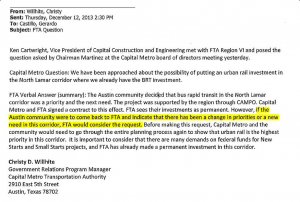“We can’t ask the Federal government to fund urban rail on Lamar/Guadalupe because they already paid for Rapid Bus, and they told us they wouldn’t pay for it, and would instead demand all the BRT money back” or variations of same.
This one has legs. I even believed it myself to an extent, once. It’s a little complicated, because nobody at the FTA is truly going to go on the record, but there’s a couple of angles here that are clearly about Project Connect misleading the public (i.e. misinforming; even lying).
In 2004, though, the project was originally marketed to voters as a “possible placeholder for future urban rail”. Unfortunately, this was before I learned I needed to save images of anything put up by Capital Metro, so you’re going to have to trust my memory on this one. Suffice to say I didn’t find it compelling back then as I believed this was an attempt to get central Austin voters to support the plan but that Capital Metro had no interest in actually following through with the “first rapid bus, then rail” angle. They took down that language right after the election, by the way.
Fast forward, then, to Project Connect in 2012.
The first angle – was it ever on the table?
At the beginning of the Project Connect process, we were told that Lamar/Guadalupe was on the table and would be fairly evaluated. We were also told for years, in no uncertain terms, that Rapid Bus should not be stopped because it was not an obstacle to urban rail there. Now, granted, I didn’t always believe this myself – note that in this very blog, back in 2006, I approvingly linked to a Statesman article about Leffingwell and McCracken halting (for a time!) Rapid Bus because they correctly determined that wasting our best rail corridor on buses no better than current #101 service was incredibly stupid.
Capital Metro and Project Connect employees went to great pains to tell people (in person) that Lamar/Guadalupe was not precluded from the urban rail corridor selection process by the presence of Rapid Bus. This is the only reason I bothered to get involved with the process! People like Jace Deloney were told by people like John-Michael Vincent Cortez that there was no obstacle to Guadalupe getting trains on it. Cortez spent the better part of an hour dissembling at an Urban Transportation Commission meeting to Deloney’s questions about Rapid Bus – saying variants of “well, we could put urban rail there, but why would you ever want to, because Rapid Bus is going to be so great”.
Put a pin in this – we’ll get back to this later.
Project Connect Phase 1 went through their ridiculous, contrived, process which was obviously designed to produce justification for the predetermined rail route to Hancock. I think most of us have finally settled on that characterization by now. But one of the most irritating things, at least to Project Connect, about this process was their failure to convince the public to abandon the Guadalupe corridor as their #1, by far, choice. Despite the flawed (on purpose) design of the study; despite all the shenanigans, people still preferred Guadalupe by large margins to either of the corridors Project Connect wanted them to prefer. People still weren’t choosing the corridors Project Connect had been designed to get them to prefer! Those ungrateful wretches!
So at the very end of the phase, Project Connect and their lapdogs  went on a full-court press to explain to people why, despite massive continuing public preference, we would not be studying Lamar/Guadalupe in Phase 2. The claim was made that they had back-channel correspondence with the FTA that indicated they would not look kindly on ripping out MetroRapid right as it was starting just to put in urban rail. Which is where we get to the next angle. But first:
This is where I really got pissed off.
A lot of people spent a lot of time on the premise that our best rail corridor was, in fact, on the table. I took time away from my job and my family to do so. Many others took much more time away from their jobs and their personal lives. So it’s incumbent on Project Connect to tell us why they lied at the beginning, or why they’re lying now, because it has to be one or the other. Either Guadalupe was on the table, in which case they lied at the end; or it was never on the table, in which case they lied at the beginning. We are owed an explanation for this. I explained that last bit in a note I sent over my Thanksgiving holiday, for god’s sake, and nobody ever even attempted to resolve this at Project Connect or at the CCAG.
The second angle – did they even ask the FTA the right question?
Any urban rail project won’t be tearing up streets right away, even if it passes in November of 2014. The first time you’d see jackhammers and bulldozers would be at least 3 or 4 years further down the road – so let’s say 2017. Additionally, as pointed out by numerous people on both sides of the issue, the proposed alternative urban rail alignment (starter) for Lamar/Guadalupe only overlaps the middle quarter or third of the Rapid Bus alignment. Finally, nobody proposed eliminating Rapid Bus immediately, although I think we can all agree that running buses like that through a construction zone on the Drag would really suck. Slightly worse than running them through normal Drag traffic!
So did they ask the FTA “What would you do if we started upgrading the middle part of the Rapid Bus corridor to urban rail in 2017 or 2018?”
Nope. According to their public statements, they asked the FTA “How about if we immediately stop Rapid Bus1 and start working on urban rail here. How would you guys feel about that?”
Of COURSE the FTA said “you’d have to pay us back our Rapid Bus money”. To that question, why would you expect anything else? But even if we had to pay back the Rapid Bus money, it’s still peanuts compared to how much money we’re going to spend on Urban Rail, both Federal and local.
To equate “Can we just immediately stop Rapid Bus right now” with “Would you mind if we started upgrading the middle part of the corridor 3 or 4 years after service begins, probably continuing to run Rapid Bus as-is on the north and south ends of the corridor” is disingenuous. Misleading. Dishonest. Some might even say – a lie. To say nothing of the fact that during this phase of planning, we’re supposed to be talking about ‘corridors’, not ‘streets’; and some people like “OurRail” are proposing running urban rail a block off the Drag anyways, further reducing the area of supposed conflict to just a mile or two.
Finally, we heard from the guy at Capital Metro who planned the whole Rapid Bus project. Surely he’d set all of the Lamar/Guadalupe partisans right. Surely he’d line up with the fine leaders of the political machine on this one. Right?
The third angle: The guy in charge of Rapid Bus planning
I watched a CCAG meeting where Surinder Marwah spoke, and have been on a lot of email threads where he was CC’ed. He responded in onethread to a question by me of whether John Langmore had ever been forced to explain why the Rapid Bus project manager would support rail on Guadalupe (this is an edit from early versions of this post – I missed it the first time around). His response had a bunch of good technical detail about the FTA, useful life of bus projects, the definition of “permanence”, etc. which I’d have to go seek permission to repost.
However, Lyndon Henry has already done the legwork on this one. From an article in Railway Age:
Indeed, Surinder Marwah — the Capital Metro planner who originally designed the MetroRapid project and helped secure FTA Small Starts funding — corroborates MetroRapid’s role as a precursor to urban rail, and disputes that the project was ever intended to block rail in the G-L corridor. Marwah ranks as a strong and knowledgeable advocate of urban rail in the corridor.
Oops. Well, surely the FTA itself can be trusted to back up the leaders of our local political machine?
The fourth angle: The FTA’s Actual Public Response
Posted by the Central Austin CDC and others, this is the actual content of the response from the FTA to requests for information about this issue:
What the FTA says here is that they would consider funding urban rail in this corridor as if it was any other corridor; but they might want some of the BRT money back (because, of course, they were asked the wrong question – listed above).
Even when asked a leading question implying a complete abandonment of the “BRT” investment, the FTA said they’d still be willing to fund urban rail in this corridor. They didn’t promise they would; but for the leaders of our political machine to characterize this, as they have, as “the FTA won’t pay for urban rail there because they already paid for Rapid Bus there” is a LIE.

That’s all the time I have for now. Look for edits as I get more.
 Further reading
- Lyndon Henry provides more details about the communication with the FTA.
- Dan Keshet writes “The Austin Precedent: Bus Improvements Block Rail“, with lots of good activity in the comments about the precedent this would set, if actually true.
- Julio Gonzalez-Altamirano wrote “O BRT, Where Art Thou“, in which the timing issue, as well as depreciation of the (relatively short-lived) investment is discussed in detail.
two months BEFORE the buses were to start running ↩
